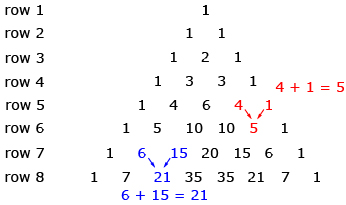Lesson 4
1. Lesson 4
1.6. Explore 2
Module 8: Permutations, Combinations, and the Binomial Theorem
In Try This 2 you may have found that each row of Pascal’s Triangle can be determined by adding adjacent numbers in the preceding row.

You may have noticed some of the following patterns:
- Each row is symmetrical.
- Row n has n numbers in it.
- The second number of the row is equal to n − 1.
- The sum of row n is 2n − 1.
Although Pascal’s triangle has many interesting patterns, the pattern of the triangle’s construction is most important for this lesson.
The coefficients of the binomial (x + y)n can be determined using row n + 1 of Pascal’s triangle. To determine the expansion of (x + y)7, use row 7 + 1, or row 8, of the triangle to determine the coefficients. Watch Binomial Expansion with Pascal’s Triangle to see a complete description of how to expand (x + y)7.
Self-Check 1
Complete questions 1.a., 1.b, 4, 7.a., 7.b., 11.a., 11.b., and 14 on pages 542 and 543 of the textbook. Answer
